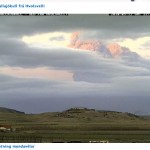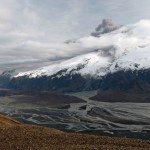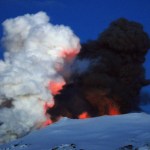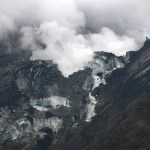Eyjafjöll
Eyjafjallajökull erupting in the spring of 2010.
I have a request for all of you Eruptions readers! In a few weeks I will be giving a talk here at Denison on the Eyjafjallajökull eruption and especially the aspects of how the eruption unfolded on the web. I think the shared experience of the seismicity, fissure vent eruption and explosive eruption - along with all the ramifications of the air traffic stoppage over Europe - was a fascinating phenomenon. So, I ask you readers: How would you describe your experience on Eruptions during the Eyjafjallajökull events? By that I mean in terms of…
News!
The summit crater lake at Gorely in Russia, taken on June 21, 2010. Image courtesy of KVERT.
Eruptions readers have been abuzz about how KVERT will be closing shop (yet again) at the end of June. This would, of course, leave no local monitoring and expertise in the very active Kamchatka Peninsula and Kuril Islands in Russia. Right now Shiveluch and Gorely are both showing signs of increased eruption (along with other volcanoes in the arc). In fact, Gorely, which hasn't erupted since 1986, looks primed to have an eruption, with increased tremors, steam-and-gas emissions and a new…
The crater lake at Eyjafjallajökull as seen on June 11, 2010. Image from the Icelandic Met Office by Sveinn Brynjólfsson.
After keeping us transfixed for almost two months this spring, Eyjafjallajökull has slowly drifted from the headlines. However, this doesn't mean that interesting things - volcanologically-speaking - have stopped happening at the Icelandic volcano. For one, a crater lake has now been spotted at the summit vent of the volcano. This lake is steaming vigorous, but at the end of last week, the Icelandic Meteorological Office and the Institute of Earth Sciences declared…
Looking for some volcano news - you've found it.
A shot of volcano "tourists" near the erupting Pacaya. Photo by the Associated Press.
Eruptions reader Dr. Boris Behncke dropped a note that Kilauea has not one but two active lava lakes right now. The lava lakes can be seen on the webcams for the Halema`uma`u Crater and the Pu`u O`o flank vent. The latest status update from June 6th by the USGS Hawaiian Volcano Observatory talks about both the summit and rift activity (video) on Kilauea as well. Meanwhile, Hawaii 24/7 has a piece in the Volcano Watch series about whether residents of Maui…
Image of the Eyjafjallajökull's ash taken on May 26, 2010, courtesy of the NASA Earth Observatory.
Eruptions readers were closely following increasing tremors at Eyjafjallajökull this afternoon/evening wondering if there was a new eruption starting but with the weather not cooperating, no one was sure. However, this evening the Icelandic Met Office released a statement (Icelandic) saying that a small explosion of gas and ash did occur today. The update is only available (so far) on the Icelandic version of the IMO website - so I had to work through a Google Translate version of the story…
This week has been destroyed by workshops and my last death throes with a paper I am submitting on my research in New Zealand. And to think, I thought it might settle down a little after the students left.
To news!
Ash fall on a taxi cab near Guatemala's Pacaya.
Pacaya in Guatemala erupted yesterday causing evacuations of people near the volcano and the closure of Guatemala City's main airport. Pacaya is a mere ~25 km from the capitol of this Central American nation. Tragically, a news reporter from one of the capitol's TV stations died when they were struck by volcanic debris, again…
Brief news!
Lava flows reaching the sea at Kilauea in Hawai`i. Image from November 2009, courtesy of HVO/USGS.
The Alert Status at Cleveland in the Alaskan Aleutian Islands was raised to Yellow (Advisory) by the Alaska Volcano Observatory after new signs of activity emerged. The latest report from AVO on the volcano says a thermal anomaly has been spotted at the summit, which typically is one of the first signs that the volcano is entering an eruption period. However, there is no real-time seismic monitoring for Cleveland, so that is the only clue (right now) that AVO has. Cleveland is a…
For all of you going into withdrawal now that Eyjafjallajökull seems to have quieted down, there are two eruptions of note that aren't in the North Atlantic:
Undated image of the Barujari cone at Mt. Rinjani in Indonesia.
Arenal in Costa Rica - which is almost always sputtering away - had a more significant explosive and effusive event today. The volcano produced enough ash, bombs and gas emissions - along with 8 lava flows (or avalanches, depending on the source) - to prompt the evacuation of the National Park around the volcano. Arenal has had numerous strombolian eruptions over the last…
The small steam plume from Eyjafjallajökull on May 23, 2010, where explosive eruptive activity has ceased for now.
The big news over the weekend, at least volcanically, was that Eyjafjallajökull seems to have entered a period of relative quiet. The eruption has died down dramatically, with the last ash explosion occurring two days ago. Since then, the vent has still be producing a significant steam plume that reaches 3 km / 10,000 feet, but none of the ash-laden explosions that marked the earlier parts of the eruption have occurred (meaning the airspace over the North Atlantic and Europe…
The ash plume from Eyjafjallajökull, piercing the cloud deck above the volcano. Image courtesy of the Icelandic Met Office, taken on May 13, 2010. See the latest report on the eruption.
With all the rapid fire news on eruptions as of late, combined with my busy schedule during the school year, I haven't been able to post as many articles on some basic aspects of volcanology. I will try to remedy some of this over the summer and the first will look at volcanic ash and specifically the ash from Eyjafjallajökull. I've taken some photomicrographs of the ash from Eyjafjallajökull (sent to me…
The latest Weekly Volcanic Activity Report from our friends at the Smithsonian Global Volcanism Program and the USGS.
Highlights (not including Eyjafjallajökull - you can check the latest IMO update on that eruption and the latest VAAC ash advisories.):
Villarrica in Chile was raised from Alert Level 1 to 2 by the Chilean SERNAGEOMIN after an increase in seismicity, a rise in the lava lake levels at the summit and more vigorous fumarolic activity.
In the first update in a while, a small ash plume was noticed at Chaiten in Chile, rising to ~1.8 km (8,000 feet) from the new domes.
Karymsky in…
News, news, news!
Ash from Eyjafjallajökull piling up on a roof at Seljavellir. Image courtesy of the IMO, by Ari Tryggvason.
The latest from Eyjafjallajökull has the volcano continuing to puff away - producing intermittent airspace closures over Europe. The Icelandic Met Office reports a ~7 km (21,000 foot) ash plume, but they note that the explosivity of the eruption seems to have waned some since a maximum on May 13. Right now, the IMO estimates the eruption rate at ~200 tonnes/second. Lets put that in a little perspective - a Ford F-150 pickup weighs about 2 tonnes, so the volcano is…
Some news for a sleepy Monday:
Mt. Hood in Oregon.
The ash from Eyjafjallajökull is, once again, causing significant airspace closure over northern Europe - close of 1,000 flights today. However, much of the closures are fairly short-lived, but that isn't keeping people happy. The eruption hasn't actually changed much, just that the winds are bringing ash towards Europe. The ash for the next few days will likely effect the England, Scotland, Ireland, Netherlands, France and possibly other parts of northern Europe (along with airspace over Greenland and the north Atlantic). The ash plume is…
Time to play a little catch up ...
Eyjafjallajökull erupting in early May. Image by and courtesy of Martin Rietze.
A brief update on our friend Eyjafjallajökull - the eruption plume from the volcano was considerably taller yesterday, reaching 6-9 km (20,000-30,000 feet), but prevailing winds meant the ash hazard was confined to areas in the middle of the North Atlantic and northern parts of the British Isles. However, even as the ash hazard for Europe wanes (for now), you shouldn't forget the amount of ash being dumped on parts of Iceland. If you want to see some stunning images of the…
An aerial view of Eyjafjallajökull erupting on May 11, 2010, with the extent of the black ash from the eruption on GÃgjökull clearly evident, along with the cracks in the glacier near the lava flow. Photo from the Icelandic Met Office, by Sigurlaug Hjaltadóttir.
Since this past weekend's disruptions due to Eyjafjallajökull, the air over Europe has cleared and most of the airports in Spain, Portugal and Germany (along with those in Morocco) have reopened. The current ash advisory by the London VAAC looks like it will only effect transatlantic flights and Iceland itself, with the ash cloud…
I an in the home stretch for grading exams, so just a quick update for today:
The evidence of floods from the Eyjafjallajökull eruption, taken on May 1, 2010 by Dr. Joe Licciardi.
Airports now as far south as Spain, Morocco and the Canary Islands are facing closures due to the Eyjafjallajökull ash. The latest London VAAC ash advisory has the ash wrapping around western and southern Europe, which I am sure is making life interesting for routing transatlantic flights into Europe. The flights within Europe don't seem to be that effected according to Eurocontrol - and they have even dropped…
A shot of the summit area of Eyjafjallajökull, showing the twin steam-and-ash plumes from the lava flow and active vent. Picture taken by Dr. Joseph Licciardi (UNH).
Over the weekend, the newly reinvigorated ash eruptions from Eyjafjallajökull combined with favorable winds meant that ash from the eruption closed airspace over swaths of Europe, including Ireland, Spain, Portugal, Italy, Austria and Germany. These disruptions are continuing into the new week, although most of the disruption is for transatlantic flights. However, the threat of ash is more present than ever, as Ryanair…
The GÃgjökull outlet glacier on Eyjafjallajökull, showing the steaming lava flow carving its way through the glacier. Image taken May 5, 2010 by Dr. Joseph Licciardi.
A quick update on the ongoing activity at Eyjafjallajökull:
The activity at the volcano continues to be more explosive during the last few days than it was in the previous week, leading to more potential for airspace closures over Europe if the winds were to shift. Currently, the VAAC ash advisory only seems to suggest that even Spain may get a taste of the ash sometime tomorrow, but most of Europe will be OK. However,…
Grading grading grading!
A webcam capture of the eruptive plume from Eyjafjallajökull on the morning of May 6, 2010.
News:
A quick update on the Eyjafjallajökull eruption: The volcano has been producing an impressive ash plume over the last day (see image above). The current ash plume is reaching 5.8-6 km height (19-20,000 ft) - and causing some trouble over Ireland and Scotland. However, much of airspace closed yesterday has reopened (for now). You can see two new images of the ash plume over at the NASA Earth Observatory. As for the continued fallout from the ash plume from April,…
A shot of the strombolian activity at the vent of Eyjafjallajökull, taken on May 4, 2010. Image courtesy of the Iceland Met Office.
The latest news from the Eyjafjallajökull eruption has the volcano erupting more explosively again (see above), possibly due to an increased influx of water into the vent area - in any case, the ash has become denser (by volume in the air) and the plume is higher (see below) than in the last couple of weeks. The rate of lava flow extrusion has also gone down in the last few days. The latest update from the Iceland Met Office has a lot of details on the current…





